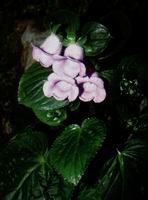
Cult. Kew Gardens, phot. A. Weber (1990)
Full name and orig. publication: Gloxinia L'Hér., in Aiton Hort. Kew. 2: 231 (7 Aug. - 1 Oct. 1789).
Etymology: Named after Benjamin Peter Gloxin (1765-1795), an Alsatian physician and botanist.
Synonyms: Eucolum Salisb. (1796), Escheria Regel (1849), Salisia Regel (1849).
Infrafamilial position: Gesnerioid Gesneriaceae (Gesnerioideae) - Gloxinieae.
Description: Terrestrial perennial herbs with scaly rhizomes (absent in G. xanthophylla). Stem erect. Leaves opposite, ± isophyllous, rarely ternate, with 5-9(-12) pairs of veins. Stem and leaves almost glabrous or pilose. Flowers solitary, emerging from the axils of opposite or alternate bracts, forming together a terminal, indeterminate raceme; pedicels ebracteolate. Sepals free. Corolla broadly tubular to campanulate, white, pink, purple or brownish, limb of subequal to unequal lobes, lobes entire to toothed or fimbriate. Stamens 4, anthers laterally or apically coherent. Nectary annular or absent. Ovary half-inferior to inferior; stigma capitate to stomatomorphic. Fruit an ovoid to elliptical dry rostrate capsule, loculicidally dehiscent without splitting the hypanthium. Seeds numerous, minute, rhombic to ellipsoid.
Chromosome number: 2n = 26.
Species number: 3.
Species names (incl. publication and synonyms): See Skog, L.E. & J.K. Boggan. 2005: World checklist of Gesneriaceae: http://persoon.si.edu/Gesneriaceae/Checklist.
Type species: Gloxinia maculata L.Hér., nom. illeg. = Gloxinia perennis (L.) Fritsch
Distribution: South America, primarily in the Andes (but G. perennis widely cultivated and naturalized outside the Andes), G. erinoides extending into Central America (Costa Rica).
Ecology: Terrestrial plants growing in small or large colonies on rocks, on river banks, or in shaded damp places in forest; the plants are dormant during winter, reduced to the underground rhizomes.
Notes: The wide circumscription of Wiehler (1976) (mainly based on the chromosome number and hybridization experiments) proved unnatural. Molecular evidence has been presented that Gloxinia must be restricted to three species: G. perennis, G. erinoides (formerly placed in the monotypic genus Koellikeria), and G. xanthophylla (formerly placed in the monotypic genus Anodiscus) (Roalson et al. 2005a,b, Boggan 2006). A characteristic feature of the three species is the inflorescence, a terminal, open raceme, which type is otherwise rare (Smithiantha). G. perennis and G. erinoides have fragrant flowers. G. perennis attracts male euglossine bees by producing perfume (secreted from an osmophore) instead of nectar. It was one of the first plants (and the first member of Gesneriaceae), in which pollination by perfume-collecting male euglossine bees was observed (Vogel 1966).
Selected references: Vogel, Österr. Bot. Z. 113: 302-361 (1966), pollination ecol.; Wiehler, Selbyana 1: 380-388 (1976), emend. & rev.; Hoehne, Arq. Bot. Estado Sao Paulo 3: 315-335 (1964), reg. rev. (Brazil); Skog, Ann. Missouri Bot. Gard. 65: 929-932 (1979), reg. rev. (Panama); Roalson, Boggan, Skog, Zimmer, Taxon 54(2): 389-410 (2005a), molec. syst.; Roalson, Boggan, Skog, Selbyana 25(2): 225-238 (2005b), tax.; Boggan, Gesneriads 56 (3): 26-32 (2006), surv.
Bibliography: See Skog, L.E. & J.K. Boggan. 2005. Bibliography of the Gesneriaceae. 2nd edition: http://persoon.si.edu/Gesneriaceae/Bibliography.
Illustrations:

|
Gloxinia perennis (L.) Fritsch
Cult. Kew Gardens, phot. A. Weber (1990) |
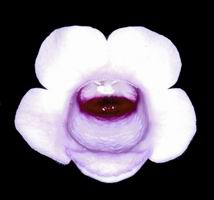
|
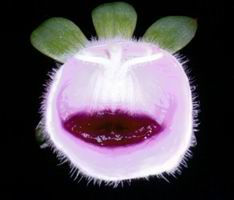
|
Gloxinia perennis (L.) Frisch
Complete and dissected flower showing the osmophore |
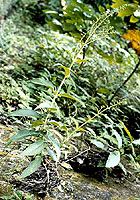
|
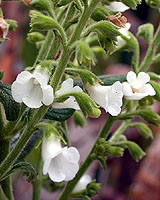
|
Gloxinia xanthophylla (Poepp.) Roalson & Boggan [formerly Anodiscus xanthophyllus Poepp.] Left: Peru, phot. L.E. Skog (1978) |
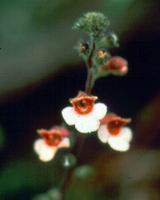 |
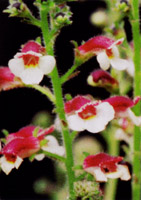 |
Gloxinia
erinoides (DC.) Roalson & Boggan [formerly Koellikeria erinoides DC.] Left: Panama, Cerro Colorado, phot. L.E. Skog
(1978) |
last modified: 2007-01-05